Are you a parent trying to work from home while taking care of your kids? You’re not alone. A surprising 58% of Americans can work remotely at least once a week. But with childcare costs going up by 41%, many families struggle to balance work and parenting at home.
How can you make your home office both productive and kid-friendly? Let’s look at some practical tips to turn your space into a place of work and family harmony.
Communication is Key: Inform Colleagues About Your Situation
Working from home as a parent means you need to talk openly with your team. Let them know you have kids at home during work hours. This helps everyone understand and prepare for any surprises.
It’s important to set clear boundaries with your team. Tell them when you’re available, what might interrupt you, and how you’re trying to keep work smooth. Being open helps build a supportive team atmosphere.
Manage Expectations and Prepare for Occasional Disruptions
Remote work can be tricky, with managing expectations and dealing with surprises. Be honest with your team about your home life and the chance for interruptions. This way, they can plan better and not get surprised.
- Communicate your availability and work schedule
- Inform colleagues about possible disruptions from your children
- Discuss ways to lessen the impact of these interruptions
- Ask your team to be understanding and patient
By sharing your situation and working together, you can make a great remote work team. Everyone benefits from this approach.
Designate a Dedicated Workspace
Creating a dedicated workspace in a small home can boost your productivity. Look for unused spots like corners or alcoves to turn into a dedicated office. By focusing on ergonomics and organization, you’ll make a space that’s both comfy and efficient for working from home.
Utilize Underused Areas for Maximum Productivity
Finding and using hidden spots in your home can change your work game. Think about turning a corner, nook, or even a closet into your office. This approach not only uses space well but also helps keep work and personal life separate. It leads to better focus and balance.
When setting up your dedicated workspace, think about ergonomics. Get an adjustable desk and chair for good posture and to avoid health problems. Add storage and organizers to keep things tidy. This makes your space more productive.
Make your dedicated workspace your own. Think about lighting, smells, and background sounds to boost focus and motivation. Tailoring your space to your needs makes you feel more at home and productive.
Adjust Your Work Routine to Accommodate Kids
As a working parent, it’s important to adapt your work routine for your kids. This might mean waking up early, telling your team when you’re free, and taking breaks to spend time with your kids.
More parents are working from home with their kids now. This means they need to be ready for calls and interruptions. Having a special workspace at home helps a lot.
Many parents wake up early to work and spend time with their kids. It’s vital to talk well with your team to handle work and family duties.
- Make time for your kids during the workday, balancing work and family.
- Use noise-canceling headphones or headsets to block out distractions at home.
- Set clear rules and routines so your kids know when you’re working and when you’re free.
Working from home can be a big advantage for parents. It lets them manage distractions and adjust their schedule for their family. With some creativity and good communication, you can find a balance that works for everyone.
Incorporate Quality Time with Your Children
Working from home with kids requires a good balance. It’s key to plan quality time with them. This helps your kids grow and keeps you happy too. By doing so, you build a strong family bond and make your kids feel important.
Balance Work and Parenting by Scheduling Breaks
Creating a routine with breaks is vital. Set times for play, learning, or just hanging out. This way, you give your kids the attention they need and stay productive at work.
Here are some tips for scheduling breaks:
- Dedicate 20-minute increments for younger children (4 years old) to engage in free play or creative activities.
- Allow 45 minutes to an hour for older children (second-graders) to work on homework or participate in educational games and projects.
- Incorporate physical activity breaks, such as following along with kid-friendly exercise videos, to keep your children energized and engaged.
- Encourage your kids to explore their creativity through arts and crafts projects or building with toys like LEGO or blocks.
- Set clear boundaries and communicate your availability to your children, using visual cues like “do not disturb” signs on your office door.
By planning these breaks and setting boundaries, you find a good work-life balance. This benefits your kids and keeps you focused at work.
Working from home lets you spend quality time with your kids. It also helps you create a comfortable work space. Don’t forget to take care of yourself too, taking breaks to manage stress.
Invest in Noise-Canceling Headphones or Headsets
Buying high-quality noise-canceling headphones or headsets can really help you work better at home with kids. They block out distractions and make sure you can talk clearly on video calls.
The Shure Aonic 50 headphones are top picks for work-from-home. They have amazing sound and block out noise well. The Shure MV5 microphone is also great, with clear sound in a small package.
The EPOS ADAPT 560 Bluetooth headset is a versatile choice. It has great sound and a long battery life. The HyperX Cloud Mix headset is also popular, with good sound and portability for work and gaming.
Adding accessories like Calm Strips can help you stay focused on video calls. Speks desk “toys” can also keep you engaged during long Zoom meetings.
For better ergonomics, try the Fluidstance Slope. It’s like a whiteboard for your desk. The Nulaxy adjustable laptop stand helps you get better angles for video calls.
The reMarkable2 paper tablet is great for note-taking. It feels like writing on paper but lets you digitize your notes easily.
By getting these noise-canceling headphones and other tools, you can make your work space better. This helps you stay focused and productive while working from home with your kids.
Embrace Flexibility and Adapt to Changing Needs
Working from home as a parent means being flexible and adapting to your family’s needs. It’s important to see that changes are normal and can keep you positive and avoid burnout.
Be Understanding and Patient with Yourself and Your Kids
Handling work and taking care of kids is a challenge. Be patient and understanding with both yourself and your children. Remember, there will be times when things don’t go as planned. Stay flexible and adaptable to handle these moments.
Companies like Red Rooster Coffee in Virginia understand the value of flexibility. They offer on-site childcare to support their employees. An employee mentioned this as a key reason for returning to work.
Bayer also values flexibility, introducing self-directed teams. This change aims to boost autonomy and innovation. It helps employees balance work and life better.
Take inspiration from these companies to make your WFH space more flexible and supportive. Being understanding and patient with yourself and your kids is essential for success in this unique situation.
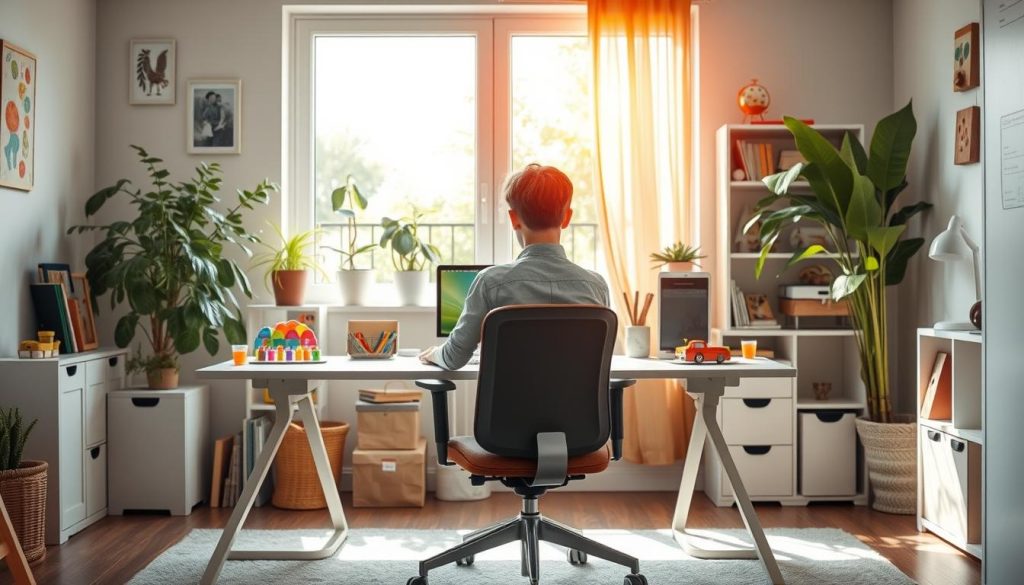
Kid-friendly WFH Office Tips for Different Age Groups
Creating a kid-friendly WFH office needs careful planning for each age group. Whether you have babies, toddlers, or early school-aged kids, using age-appropriate strategies, engaging children, and educational resources is key. This helps make a productive and family-collaborative space.
Babies: Maximizing Nap Times and Using Hands-Free Tools
Parents with babies can work well during their nap times. Babies need two to three naps a day. Working with a partner can help manage childcare, giving you time to focus.
Tools like babywearing, dictation apps, and multi-platform collaboration keep you productive with your baby nearby.
Toddlers: Establishing Boundaries and Promoting Independence
Toddlers love routine and clear work and home boundaries. Practice sessions teach them about work. Flexible screen time helps you focus.
Have Plan A and Plan B activities for toddlers. Also, coordinating virtual playdates helps their social skills.
Early School-Aged Children: Collaboration and Educational Resources
Parents with early school-aged kids should tag-team and use educational screen time. It’s important to clearly communicate what’s expected. Engage your kids in fun communication methods and create a dedicated work area.
| Age Group | Key Strategies |
|---|---|
| Babies |
|
| Toddlers |
|
| Early School-Aged Children |
|
By using age-appropriate strategies, engaging children, and educational resources, parents can make a WFH office friendly for kids. This supports productivity and creates a positive space for them.
Babies: Maximize Nap Times and Use Hands-Free Tools
For parents working from home with baby-friendly WFH setups, using naptime wisely and hands-free tools can change everything. Babywearing, dictation apps, and flexible scheduling help you work well while caring for your baby.
Use naptime to do important work. Get noise-canceling headphones or a good headset to keep your hands free. Apps that turn speech to text can make your work easier, letting you write emails or reports while holding your baby.
Adjust your work to fit your baby’s sleep schedule. Create a flexible work-life balance that meets your child’s needs. This way, you can work efficiently and spend quality time with your baby.
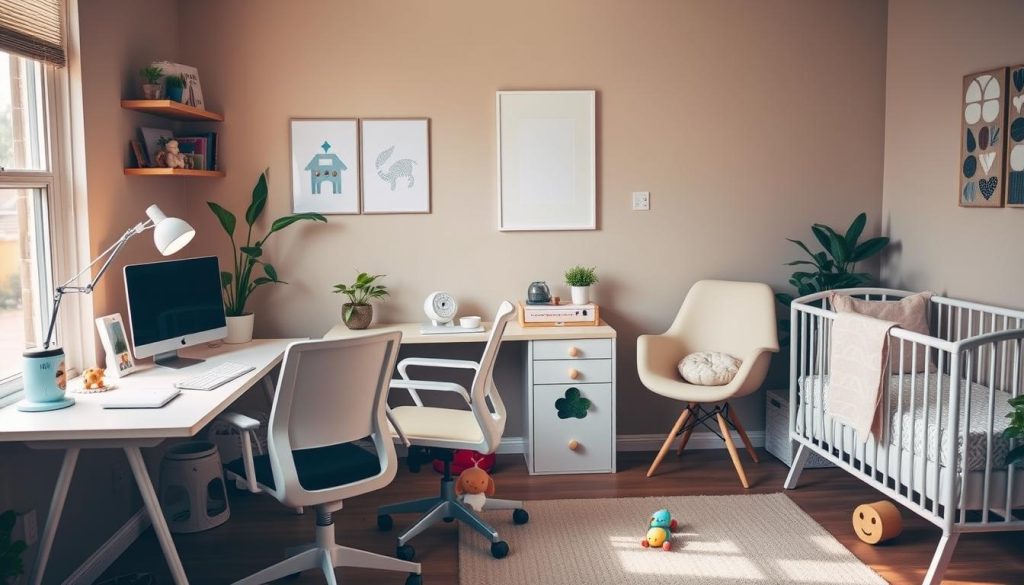
Babywearing, Dictation Apps, and Flexible Scheduling
Wearing your baby in a carrier or sling keeps them close and happy. Use voice-to-text apps with it, and you can work without disturbing your child. A flexible schedule lets you fit work into your baby’s routine, making the most of nap times.
Toddlers: Loosen Screen Time Limits and Get Creative
Managing a toddler-friendly WFH space is all about balance. A bit of screen time flexibility and lots of creative activities are key. It’s important to find a balance that lets you work and spend quality time with your tag-team parenting partner.
Video chats are great for keeping your toddler connected with family or a trusted sitter. Try indoor swings, sensory boxes, and letting them cut soft foods for fun, screen-free play. Mess-free activities like Magna-Tiles, pipe cleaners, or dry-erase markers on mirrors or windows can also spark creativity.
- Try audiobooks for a screen-free entertainment option.
- Mini trampolines and pillow forts can channel your toddler’s energy in a productive way.
- Water tables or buckets on warm days can keep them entertained without causing disturbances.
- Educational toys like the LeapFrog Learning Friends 100 Words Book can support early literacy skills.
By being flexible and tapping into your toddler’s curiosity, you can balance work and play. This makes your toddler-friendly WFH situation a success. Check out this guide for more ideas.
Early School-Aged Children: Coordinate Playdates and Engage in Learning
Parents of early school-aged children face new challenges with work-from-home (WFH) life. Coordinating playdates with neighbors and finding educational activities can be a lifesaver. These efforts keep kids happy and busy, giving you a chance to focus on work.
Educational Games, Movies, and Neighbor Collaborations
Use educational games, movies, and group learning to help your child grow. Set up virtual playdates with neighbors using platforms like Roblox. This way, kids can play and learn together, helping you get some work done.
It’s important to control screen time. Plan activities that are both fun and educational. Use online games and documentaries that are right for their age. This keeps them entertained and learning while you work.
By planning playdates and educational activities, you can work from home effectively. Your kids will stay happy and stimulated, helping you manage the pandemic’s parenting challenges.
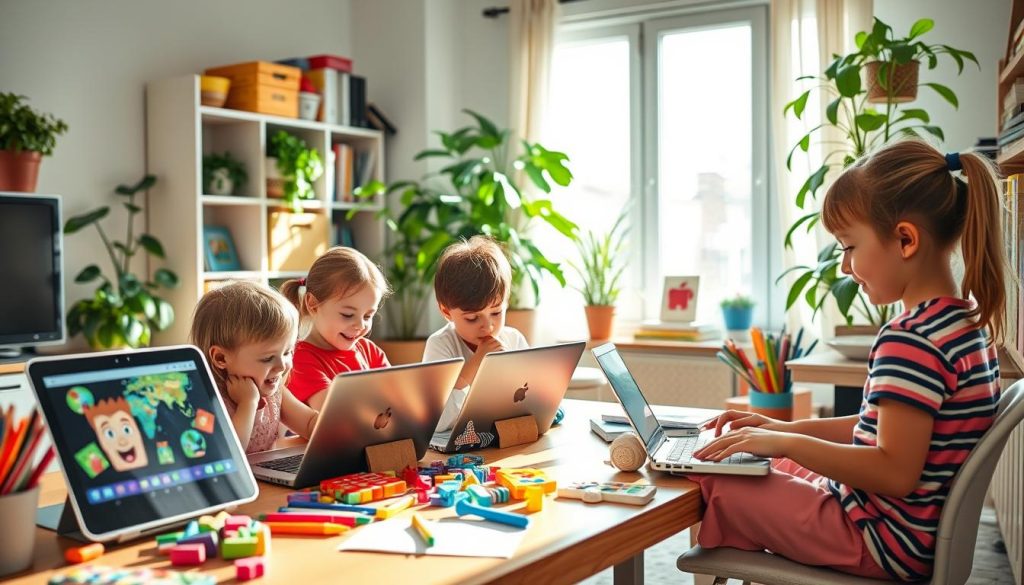
Ergonomic Considerations for Kid-Friendly Workstations
As more people work from home, making your office space ergonomic and safe for kids is key. This means getting adjustable desks and chairs. Also, use organizational solutions to make the most of your space and keep it clean.
Adjustable Desks, Chairs, and Organizational Solutions
Adjustable furniture is a big help in setting up an ergonomic workstation that grows with your kids. Look for adjustable desks that can change height for you and your kids. Ergonomic chairs with lumbar support and adjustable features help keep your posture right and avoid discomfort.
Use organizational solutions to make your space better and keep it neat. Shelves, storage bins, and cable management tools help keep your kid-friendly workstation looking good and working well. Space optimization and comfort are important for a productive and safe area for you and your kids.
Investing in the right adjustable furniture and organizational solutions makes a ergonomic workstation that supports your work and your kids’ needs. A well-designed and comfortable workspace boosts your productivity and well-being while working from home.
Creating a Positive and Productive Environment
Creating a positive and beautiful work space at home can really help you stay focused and happy. Add personal touches like family photos or artwork. Choose decor that makes you feel good and energized. This helps you stay focused and feel good, even when working from home with kids.
Make your workspace your own by adding things that show your personality. A cozy corner, a bright wall hanging, or a small plant can turn your home office into a happy place.
Also, organize your space to work better. Set up different areas for work, play, and rest. Use apps like Flipd or Toggl to help you stay on track and productive.
| Tip | Benefit |
|---|---|
| Personalize your workspace | Boosts mood and energy |
| Organize your space | Enhances productivity |
| Batch similar tasks | Increases focus and efficiency |
| Use time-management apps | Improves time-tracking and productivity |
Creating a great work environment at home with kids is a challenge. Be kind to yourself and ask for help when you need it. By making your workspace personal and positive, you can create a great work-life balance at home.
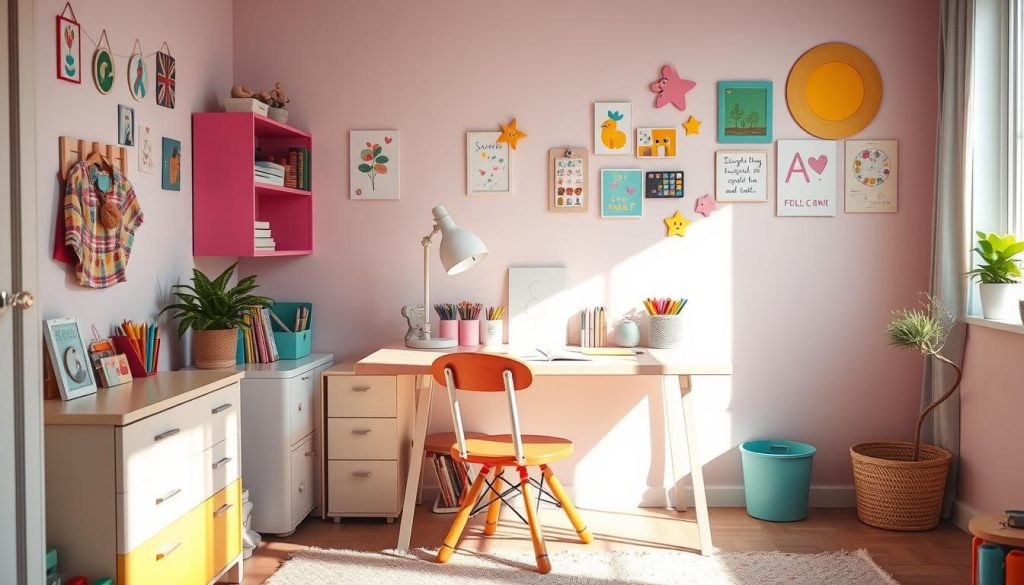
Safety First: Childproofing Your WFH Office
Creating a safe WFH space with kids is key. It’s important to childproof your home office. This means securing cords, covering outlets, and removing dangers to keep your kids safe.
Securing Cords and Outlets
Loose cords and open outlets are dangers for kids. Start by bundling and hiding cords and wires. Use cord organizers or cable ties to keep them safe. Also, cover outlets to stop kids from getting shocked.
Place your desk where you can watch your kids. This helps you catch any dangers fast.
Addressing Potencial Hazards
Look around your WFH space for dangers like sharp edges or heavy things. Use safety gates and corner guards to protect these areas. Choose strong, safe furniture and storage to avoid accidents.
Keeping your WFH office safe is good for your kids and your work. It lets you focus on your job without worry. By making your WFH space safe, you create a better work and home environment for everyone.
| Childproofing Measure | Benefits |
|---|---|
| Securing Cords and Cables | Prevents entanglement and strangulation hazards |
| Installing Outlet Covers | Protects against electric shocks and burns |
| Using Furniture Anchors | Prevents furniture from tipping over and causing injuries |
| Applying Corner Guards | Reduces the risk of bumps and bruises from sharp edges |
Balancing Work and Parenting: Scheduling Strategies
Keeping a good work-life balance is key for working parents, even when working from home (WFH) with kids. Using smart scheduling methods, focusing on what’s important, and setting clear boundaries can help manage time well. This reduces stress in this unique situation.
Creating a daily routine that fits both work and family is a good start. You can set times for work, breaks with kids, and family activities. By prioritizing and managing time well, parents can balance work and family duties. This helps avoid burnout.
- Make a clear daily schedule: Set times for work, childcare, and personal breaks to feel in control.
- Talk to your employer and colleagues: Let them know your situation and set boundaries on when you’re available.
- Use technology to stay productive: Apps, virtual tools, and time trackers can help you work better.
- Focus on important tasks: Do the most critical work first and delegate less important tasks to manage your load.
- Take breaks and family time: Short breaks and dedicated family time are key to recharging and bonding.
By using these scheduling strategies, working parents can find a better balance. This leads to more productivity, less stress, and a more rewarding life at work and home.
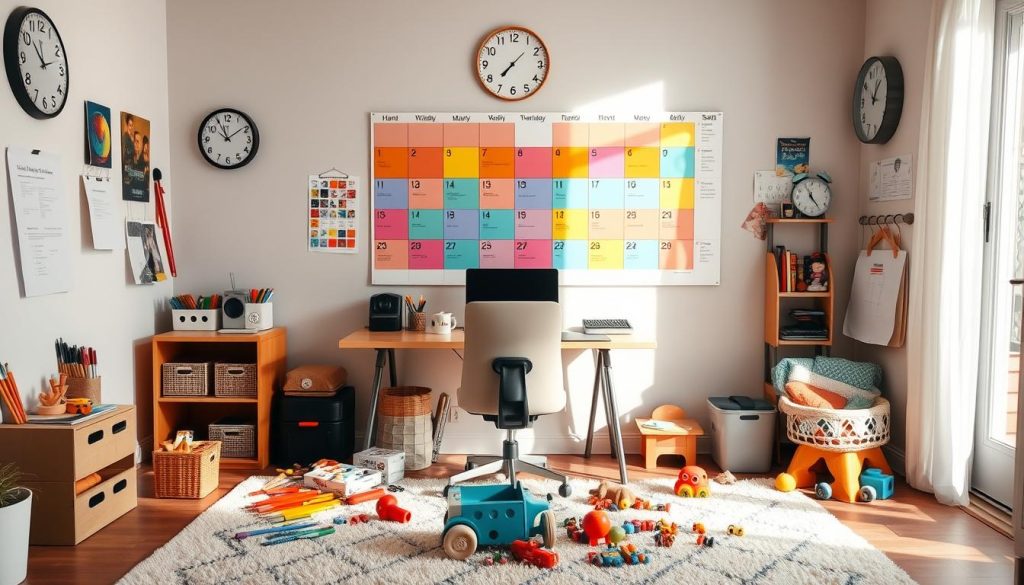
| Scheduling Approach | Benefits | Considerations |
|---|---|---|
| Partner Swap | Allows parents to focus on work during designated shifts | Requires coordination and alignment with partner’s schedule |
| Short Shifts | Enables parents to manage work and parenting in smaller chunks | May require more frequent communication with employers |
| Video Shifts | Provides flexibility for parents to manage work and childcare | Ensures availability of reliable internet and video conferencing tools |
By adopting these scheduling strategies, working parents can achieve a better work-life balance. This creates a productive and fulfilling life for both work and family.
Managing Distractions and Staying Focused
Working from home with kids can be tough because of distractions. But, you can use visual cues, set routines, and plan break times to stay on track. These steps help you work better and enjoy time with your family.
Visual Cues, Routines, and Designated Break Times
A study from Michigan State University found that a 2.8-second interruption can double errors. The Harvard Business Review said it takes 23 minutes and 15 seconds to refocus after an interruption. Use visual cues like a “Do Not Disturb” sign or headphones to show you’re working.
Having a routine helps you and your kids feel organized. Set times for breaks so you can focus on work. Studies show that meditation and white noise can boost your brain and cut distractions.
| Distraction Type | Percentage of Remote Workers Affected |
|---|---|
| Family members/Childcare | 80% |
| Social media, email, and online entertainment | 85% |
| Household noise | 60% |
| Visitors | 45% |
| Pets | 50% |
| Housework | 65% |
With some planning and creativity, you can make a work space that’s good for kids. This way, you can stay focused and work well while spending time with your family.
Embracing the Flexibility of WFH with Kids
Working from home with kids requires flexibility and adaptability. Keeping a positive mindset is key. Being open to change and seeing the benefits of this setup can help parents succeed.
Use the flexibility of working from home to meet your kids’ needs while working. You might set up a special workspace, follow a routine, or work from different places. Being able to adjust is vital. Embrace the flexibility and try new ways to balance work and family life.
Adaptability is not a problem, but a chance to grow as a parent and professional. With a positive attitude and a willingness to change, you can find the good in working from home with your kids. This can make your work and family life rewarding.
Source Links
- https://www.betterup.com/blog/working-from-home-with-kids
- https://mamaknowsitall.com/working-remote-with-kids-at-home/
- https://www.askamanager.org/2022/10/we-need-to-tell-our-remote-employees-they-cant-take-care-of-young-kids-while-theyre-working.html
- https://www.linkedin.com/pulse/6-tips-working-from-home-kids-management-specialist–1f
- https://www.poynter.org/business-work/2020/how-to-work-from-home-with-kids-around/
- https://www.hap.org/blog/2020/12/working-from-home-5-ways-to-create-a-productive-workspace
- https://www.inspiredbythis.com/business/bloggers-bright-kid-friendly-home-office/
- https://www.wishup.co/blog/6-reasons-why-a-dedicated-workspace-is-a-must-when-working-from-home/
- https://medium.com/swlh/my-tips-for-working-from-home-with-kids-b4176718c576
- https://living.geico.com/saving/life-hacks/wfh-with-children/
- https://superiorplay.com/blog/8-tips-for-keeping-your-kids-busy-while-working-from-home/
- https://www.calendar.com/blog/wfh-tips-you-can-share-with-your-kids/
- https://toddle.com.au/thecorkboard/mastering-the-art-of-working-from-home-with-young-children
- https://www.forbes.com/sites/chriscancialosi/2020/10/13/how-to-improve-your-working-from-home-game-with-these-hacks/
- https://www.headsetsdirect.com/headsets-101-noise-canceling-headsets-benefits/?srsltid=AfmBOoo0A1BXu7_uusS4J_oMOk9fryO1VAvYGiSo7R1HHS_DFyR43gEc
- https://www.forbes.com/sites/terriwilliams/2023/11/09/if-you-work-from-home-noise-cancelling-headphones-are-essential/
- https://tompkinsventures.com/future-of-work-family-friendly-innovation-trust-culture/
- https://www.forbes.com/sites/tracybrower/2024/02/14/working-from-home-as-a-new-parent/
- https://www.linkedin.com/pulse/how-flexible-working-changes-peoples-lives-molly-johnson-jones
- https://www.flexjobs.com/blog/post/dos-donts-working-from-home-kids/
- https://www.mother.ly/career-money/work-and-motherhood/work-from-home-with-kids-coronavirus-school-closures/
- https://momofeighteen.medium.com/remote-work-parenting-strategies-for-success-with-kids-in-tow-3477ee265cfe
- https://carlweinbergcpas.com/2020/06/22/5-tips-for-working-from-home-with-kids/
- https://cafemom.com/parenting/toddlers-busy-while-working-from-home
- https://www.tinycanalcottage.com/blog/2020/8/21/working-amp-studying-from-home-in-a-small-space
- https://www.helloleads.io/blog/all/remote-work/top-8-ideas-to-engage-kids-while-you-attend-important-online-meetings/
- https://www.npr.org/2020/03/15/815549926/8-tips-to-make-working-from-home-work-for-you
- https://www.physicaltherapy.com/articles/work-from-wherever-ergonomic-tips-4767
- https://www.bu.edu/articles/2020/10-ergonomics-dos-and-donts-for-those-now-working-from-home/
- https://www.ehstoday.com/health/article/21127667/ergonomics-recommendations-for-remote-work
- https://hiring.monster.com/resources/workforce-management/company-culture/how-to-manage-employees-working-from-home-with-kids/
- https://thehavenlist.com/how-to-stay-productive-while-working-from-home/
- https://topresume.com/career-advice/9-tips-for-working-from-home-with-kids
- https://modernwahm.com/combining-office-and-playroom/
- http://kidseatincolor.com/work-from-home-with-kids/
- https://practicalbydefault.com/work-at-home-with-young-kids/
- https://hbr.org/2020/03/a-guide-for-working-from-home-parents
- https://www.linkedin.com/pulse/wfh-dads-productivity-patience-coni-judge-phd
- https://raisingchildren.net.au/grown-ups/work-child-care/worklife-balance/work-life-balance
- https://www.aliem.com/1440-doctor-3-tips-combating-distractions-working-from-home/
- https://www.linkedin.com/pulse/child-approved-tips-how-wfh-wchildren-amita-paul
- https://www.flexjobs.com/blog/post/dealing-with-distractions-working-from-home/
- https://www.linkedin.com/pulse/working-from-home-kids-around-ben-ryrie-613oc?utm_source=rss&utm_campaign=articles_sitemaps&utm_medium=google_news
- https://www.linkedin.com/pulse/7-tips-work-from-home-parenting-busy-ceo-his-team-dave-landa

